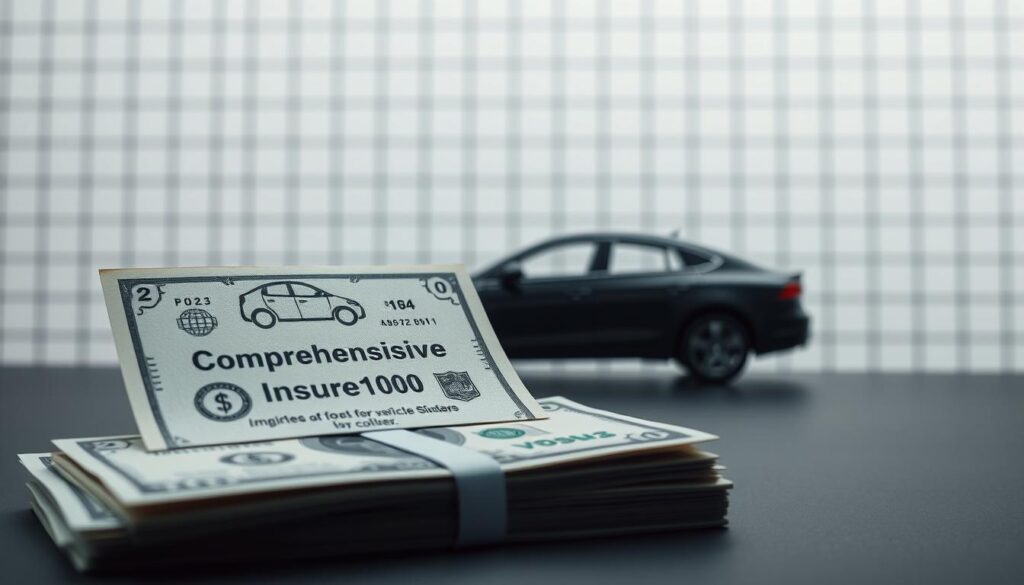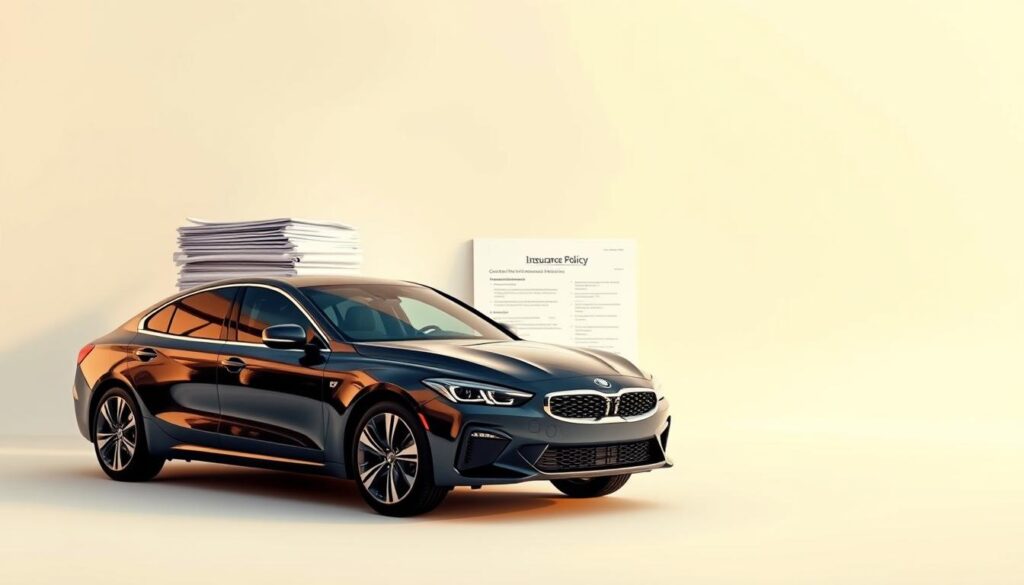Protecting your financial well-being is key. Knowing about comprehensive vehicle insurance is essential. This insurance covers damage to your car that isn’t from a crash. Things like theft, vandalism, or natural disasters can harm your car a lot.
We’ll look into why it’s important to know what comprehensive vehicle insurance covers. We’ll also see how it keeps your finances safe. We’ll give you a clear view of its good points and what it can’t do.
Key Takeaways
- Understanding comprehensive vehicle insurance is vital for financial protection.
- This insurance type covers non-collision damages, such as theft or natural disasters.
- Knowing the benefits and limitations can help you make informed decisions.
- Comprehensive vehicle insurance can safeguard your financial well-being.
- It’s essential to review your policy to understand what’s covered.
Understanding Comprehensive Vehicle Insurance
It’s key to understand comprehensive vehicle insurance to make smart choices about your auto insurance. This type of insurance covers damages to your vehicle that aren’t from a crash.
Definition of Comprehensive Insurance
Comprehensive insurance is a form of auto insurance that protects your vehicle from non-collision damages. This includes theft, vandalism, natural disasters, and animal collisions. With comprehensive insurance, your vehicle is safeguarded against many unexpected events.
Difference Between Comprehensive and Liability Insurance
Knowing the difference between comprehensive and liability insurance is crucial. Liability insurance pays for damages to others or their property if you’re at fault in an accident. On the other hand, comprehensive insurance covers damages to your vehicle not caused by a crash. Having both ensures your vehicle and financial well-being are protected against various risks.
Key Coverages in Comprehensive Insurance
It’s important to know what comprehensive insurance covers. It offers more than just basic liability, giving you full coverage. This is great for unexpected situations.
Theft Protection
Theft protection is a big plus of comprehensive insurance. If your car gets stolen, it can help pay for a new one. You just have to pay your deductible first. This is especially useful in places where cars get stolen a lot.
Natural Disaster Coverage
Comprehensive insurance also protects against natural disasters. This includes damage from hurricanes, floods, and wildfires. It helps if your car gets damaged or even totaled.

Vandalism Protection
If someone vandalizes your car, comprehensive insurance can help. It covers repairs for things like graffiti, broken windows, and more.
Animal Collision Coverage
Another key part is animal collisions. If you hit an animal, like a deer, insurance can help fix your car.
Knowing these coverages shows how valuable comprehensive insurance is. It protects your car from many risks and unexpected events.
Optional Add-Ons for Comprehensive Coverage
Make your vehicle insurance better with extra features. These add-ons offer more security and convenience. It’s important to know what’s available when you customize your policy.
Rental Car Reimbursement
Rental car reimbursement helps if your car is in the shop. It covers the cost of a rental car. This is great if you use your car a lot. It lets you keep moving while your car is fixed, so you don’t get stuck.
Glass Coverage
Glass coverage pays for fixing or replacing your car’s glass. This is good if you live in areas with hail or other weather that breaks glass.
Roadside Assistance
Roadside assistance helps in emergencies like towing or getting fuel. It’s a big help when you’re stuck.
Let’s look at how these add-ons work:
| Add-On | Benefits | Typical Cost |
|---|---|---|
| Rental Car Reimbursement | Covers rental vehicle costs during repairs | $10-$30 per month |
| Glass Coverage | Pays for windshield or glass repair/replacement | $20-$50 per year |
| Roadside Assistance | Provides towing, fuel delivery, lockout services | $20-$60 per year |
Think about these add-ons to make your insurance fit you better. They offer more protection and peace of mind on the road.
Limitations of Comprehensive Vehicle Insurance
Comprehensive vehicle insurance offers a lot of protection. But, it’s important to know its limits. It covers many damages, but not everything.
Policyholders need to know about exclusions and conditions. This helps avoid surprises when filing a claim.
Exclusions to Coverage
Some damages or situations are not covered by comprehensive insurance. For example, wear and tear, mechanical failures, or neglecting maintenance are not included. Also, using your vehicle for illegal activities or racing can cancel your coverage.
- Normal wear and tear
- Mechanical failures
- Damage from neglect or lack of maintenance
- Use of the vehicle in illegal activities
- Racing or other high-risk activities
It’s crucial to read your policy documents. Knowing what’s not covered helps you take care of your vehicle. This way, you can avoid claims being denied.

Deductibles Explained
A deductible is the amount you pay before insurance kicks in. For example, if you have a $500 deductible and your vehicle is damaged for $1,000, you pay $500. Then, your insurance covers the rest.
Choosing a higher deductible can lower your premium. But, you’ll pay more when you file a claim. A lower deductible means higher premiums but less cost when you claim.
Key considerations for deductibles include:
- Your financial situation: Can you afford a higher deductible?
- The value of your vehicle: If your car is older or less valuable, a higher deductible might be more cost-effective.
- Your risk tolerance: If you prefer to minimize upfront costs in the event of a claim, a lower deductible might be preferable.
Knowing the limits of comprehensive vehicle insurance helps you make better choices. This can save you money on premiums.
Who Should Consider Comprehensive Insurance?
Thinking about comprehensive insurance? It’s important to look at a few key points. This type of insurance covers more than just car crashes. It also protects against theft, natural disasters, and vandalism. Knowing what you need is key to making a good choice.
Vehicle Age Considerations
The age and value of your car matter a lot. If your car is new or expensive, comprehensive insurance is a good idea. It helps protect against big financial losses. But, for older cars that aren’t worth much, the insurance might cost more than it’s worth.
Check how much your car is worth and compare it to the insurance cost. If the insurance is too pricey, you might not need it. But, if you’re still paying off your car, you might have to get insurance, no matter how old it is.
Owner’s Risk Tolerance
How comfortable you are with risk also matters. If you want to be ready for anything and can afford it, comprehensive insurance is a good choice. But, if you’re watching your budget closely or don’t mind taking more risks, you might look for other options.
Think about where you live and how you drive, too. If you’re in a place where natural disasters or theft happen a lot, insurance is a smart choice. Also, if you park your car in risky spots, you might want extra protection.
In the end, choosing comprehensive insurance depends on your financial situation, car value, and how you feel about risk. By thinking about these things, you can pick the right insurance for you.
How to Choose the Right Comprehensive Policy
Choosing the right comprehensive vehicle insurance is key for your financial safety. With so many insurance companies out there, picking the best one can feel daunting.
Researching Insurance Providers
Start by researching insurance providers that offer comprehensive coverage. Look for insurers with a strong financial stability rating and good customer service reviews. Check ratings from agencies like A.M. Best or Moody’s to see if an insurer is financially sound.
Also, ask friends, family, or financial advisors for their opinions. They can share their experiences with different insurance companies.

Comparing Policy Features
After finding potential insurance providers, compare their comprehensive insurance policies. Key aspects to compare include coverage limits, deductibles, and any additional benefits or riders that may be included or available.
| Feature | Provider A | Provider B |
|---|---|---|
| Coverage Limit | $100,000 | $150,000 |
| Deductible | $500 | $250 |
| Rental Car Reimbursement | Yes | No |
As shown in the table, different providers offer different levels of coverage and benefits. It’s important to consider these differences based on your needs.
“The right insurance policy can provide peace of mind and financial security. It’s worth taking the time to research and compare your options.”
Filing a Comprehensive Insurance Claim
Comprehensive car insurance is only as good as the claim you file. Here’s how to do it right. When you need to file a claim, knowing the process can reduce stress. It also helps you get the compensation you deserve.
Steps to Take After an Incident
After an incident, follow these steps for a smooth claim process. First, document the damage well. Take photos and videos of the damage to your vehicle and any other property involved. This visual evidence is key to supporting your claim.
Next, notify your insurance provider quickly. Most insurance companies have a time limit for reporting incidents. When you notify them, give all the details, like the date, time, location, and what happened.
Then, fill out the claim form accurately. Your insurance company will give you a claim form to fill out. Make sure to fill it out carefully, providing all the information asked. Mistakes or missing information can cause delays or claim denials.
Common Claim Denials
Knowing why claims are denied can help you avoid common mistakes. One reason is incomplete or inaccurate information. It’s important to fill out the claim form correctly and provide all necessary documents.
“The most common reason for claim denial is the lack of sufficient evidence to support the claim. Policyholders should ensure they document everything thoroughly.”
Another reason claims are denied is if the damage is not covered under your policy. It’s crucial to know what your comprehensive car insurance covers and what it doesn’t.
| Reason for Denial | Description | Prevention |
|---|---|---|
| Incomplete Information | Claim form not filled out correctly or completely. | Double-check the form for accuracy. |
| Lack of Evidence | Insufficient documentation of the incident. | Take thorough photos and videos. |
| Damage Not Covered | The incident is not included in the policy coverage. | Understand your policy’s terms and conditions. |
By knowing the steps to take after an incident and the common reasons for claim denials, you can handle the process better. This ensures your comprehensive car insurance coverage works for you.
The Cost of Comprehensive Vehicle Insurance
Many things can change how much you pay for comprehensive vehicle insurance. Your location and driving history are big factors. Knowing these can help you keep your insurance costs down.
Factors That Affect Premiums
Several elements play a role in setting your insurance rates. These include:
- Location: Where you live can greatly affect your insurance costs. Cities often have higher rates because of theft and vandalism risks.
- Driving History: A good driving record can lower your rates. It shows you’re a safer driver.
- Vehicle Type: The type of car you drive also matters. Luxury or high-performance cars usually cost more to insure.
- Age and Experience: Younger, less experienced drivers often pay more. This is because they’re seen as a higher risk.

Average Costs Across States
Comprehensive vehicle insurance costs vary a lot from state to state. State laws, crime rates, and weather all play a part in these differences.
| State | Average Annual Premium |
|---|---|
| California | $1,200 |
| New York | $1,500 |
| Florida | $1,800 |
Understanding what affects your insurance rates and knowing the average costs in your state can help. This way, you can make better choices about your insurance.
The Importance of Comprehensive Coverage
Comprehensive coverage is very important. It protects against many unexpected events.
With comprehensive insurance, car owners feel secure. They know they’re safe from theft, natural disasters, vandalism, and animal collisions. This peace of mind is priceless, letting owners drive without constant worry.
Peace of Mind for Car Owners
Comprehensive insurance does more than protect your wallet; it gives you peace of mind. Knowing you’re covered for unexpected events can greatly reduce stress and anxiety about your vehicle.
Financial Protection Against Unforeseen Events
Comprehensive coverage also offers big financial protection. If something unexpected happens, it can pay for repairs or a new car. This is very important for those who use their cars every day.
| Benefit | Description |
|---|---|
| Peace of Mind | Reduces stress and anxiety related to potential vehicle damage or loss. |
| Financial Protection | Covers costs associated with repairs or replacement due to unforeseen events. |
| Comprehensive Coverage | Protects against a wide range of risks, including theft, natural disasters, and vandalism. |
Understanding comprehensive coverage is key for car owners. It’s not just about following the law. It’s about being fully protected against life’s surprises.
The Role of Comprehensive Insurance in Fleet Management
For businesses with fleets, comprehensive insurance is more than a policy. It’s a shield against many risks that could harm their operations.
Fleet management is not just about keeping vehicles running. It also means protecting them from unexpected events like natural disasters, theft, or vandalism.
Benefits for Businesses
Comprehensive insurance brings key benefits to fleet managers. It protects the company’s finances against vehicle damage or loss.
- Reduces financial burden on the company
- Minimizes downtime by ensuring quick repairs or replacements
- Enhances overall fleet management efficiency
Case Studies of Fleet Vehicles
Many businesses have learned the importance of comprehensive insurance. For instance, a logistics company faced a natural disaster that damaged their fleet. Thanks to their insurance, they were able to recover quickly.
“Comprehensive insurance was a game-changer for our fleet management. It not only covered the damages but also helped us get back on the road quickly.” – Fleet Manager, Logistics Company
Managing Your Comprehensive Vehicle Insurance Policy
Managing your comprehensive vehicle insurance policy is an ongoing task. It ensures your coverage stays relevant and effective.
Understanding the need for regular reviews and updates is key. This helps keep your coverage up to date and avoids gaps in insurance.
Regular Policy Reviews
Regular policy reviews are vital. They make sure your insurance matches your current needs. We suggest checking your policy yearly or when your personal or vehicle situation changes.
- Check if your coverage limits are still right.
- See if your vehicle’s value or use has changed.
- Update the list of drivers covered.
Also, evaluate your insurance provider’s performance. Look at their claim handling and customer service.
Updating Coverage After Major Changes
Major life or vehicle changes mean you need to update your policy. Some examples include:
- Moving to a new area with different risks.
- Buying a new vehicle that might need different coverage.
- Changes in your finances that affect your deductible or coverage limits.
Updating your policy after these changes keeps your coverage right. For example, if you’ve paid off your car loan, you might adjust your coverage.
By regularly reviewing and updating your policy, you get the right car insurance coverage options. This protects your vehicle from various risks.
Comprehensive Insurance Myths and Misconceptions
Many myths and misunderstandings surround comprehensive insurance. It’s important to know the truth to make smart choices about our coverage. This helps us understand what we really need.

Debunking Common Myths
One big myth is that comprehensive insurance covers all damages, including those to other vehicles or property. But, it only covers damages to your vehicle that aren’t from a crash. This includes theft, vandalism, or natural disasters.
Another myth is that comprehensive insurance is too pricey. While it’s true it can raise your premiums, the cost depends on several things. These include your vehicle’s value, where you live, and your driving record.
- Myth: Comprehensive insurance is unnecessary for older vehicles.
- Reality: Even older vehicles can benefit from comprehensive insurance. It protects against unexpected events.
Understanding the Real Value
Comprehensive insurance does more than just protect your wallet. It also gives you peace of mind. Knowing you’re covered can reduce stress and worry about your vehicle.
To see the real value of comprehensive insurance, think about the risks and costs without it. For example, if your vehicle is damaged in a hail storm or stolen, insurance can help pay for repairs or a new car.
| Myth | Reality |
|---|---|
| Comprehensive insurance is too costly. | The cost depends on many factors, like your vehicle’s value and driving history. |
| It’s unnecessary for older vehicles. | It protects against unexpected events, no matter the vehicle’s age. |
Frequently Asked Questions About Comprehensive Insurance
Exploring comprehensive insurance is key. It’s a crucial part of owning a vehicle. Knowing how it works helps you make smart choices.
What if I Have Multiple Vehicles?
Insuring multiple vehicles under one policy can be easier. It might also lower your costs. But, always check with your provider about their rules for multiple vehicles.
Key considerations for insuring multiple vehicles include:
- Ensuring all vehicles are covered under the same policy
- Checking for multi-vehicle discounts
- Understanding how claims on one vehicle might affect your overall premiums
How Does Coverage Work in Different States?
Insurance rules change by state. Some states have their own laws about insurance. Knowing these laws is vital to get the right coverage.
“Insurance laws and regulations can be complex and vary significantly from one state to another.” This shows why it’s important to know the local laws about vehicle insurance.
When looking at policies in different states, think about coverage limits, deductibles, and state-specific rules. This helps you find the best insurance for your needs.
Conclusion: Making an Informed Decision
Comprehensive vehicle insurance is key to protecting your car from unexpected events. Knowing the benefits of comprehensive auto insurance helps you make a choice that fits your needs and budget.
Assessing the Value
When looking at comprehensive insurance, think about its benefits and costs. Consider your car’s value, how much risk you’re willing to take, and the financial hit from damages not covered by basic insurance.
Evaluating Your Options
Take time to look at your insurance choices and pick the right coverage for you. This way, you’ll be well-protected against many risks, like theft, natural disasters, vandalism, and animal accidents. Enjoy the full benefits of comprehensive auto insurance.
